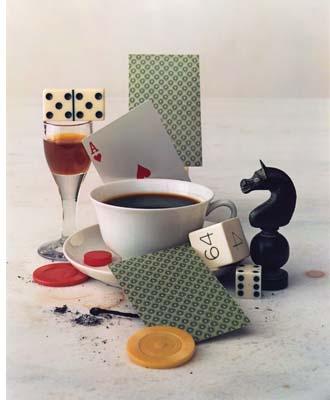Irving Penn Centennial at The Met
A career-spanning retrospective of Irving Penn (1917-2009), one of the great innovators of 20th-century photography, opens on Monday at The Met Fifth Avenue. Trained as a painter, Penn first entered the magazine world as an unpaid editorial assistant to the legendary Harper’s Bazaar at director Alexey Brodovitch, in 1936. While an art director in Saks Fifth Avenue’s advertising department two years later, Penn took up photography, shooting Manhattan street scenes as a personal interest. After a year spent painting in Mexico, he returned to New York; he became art director Alexander Liberman’s assistant at Vogue, in 1943, where he got his first break as a photographer, shooting the October cover. When the U.S. entered World War II, signed up as a photographer for with the American Field Services, returning to Vogue as a staff photographer in 1946.
Postwar couture, highly sculptural and formal, was the background against which Penn forged his indelible style. Shooting in black and white 120 format, with minimal props and lighting, he created classic images in which the clothes and the women wearing them became icons of style. The opening section of the exhibition presents a group of images from the late 1940s that define his work at Vogue, including portraits of major figures in the arts (Salvador Dalí, for one); color still lifes with odd juxtapositions of objects, which became Vogue covers; and Lisa Fonssagrives-Penn wearing a Madame Rochas dress, posed before the backdrop that became his career-long signature.
Irving Penn, The Twelve Most Photographed Models, New York, 1947; © Conde Nast, courtesy The Irving Penn Foundation.
The exhibition presents examples of Penn’s most memorable work grouped thematically, including celebrity portraits; nudes; portraits of indigenous people in Dahomey (Benin), New Guinea, and Morocco; the “small trades” series; still lifes (including the cigarette butt series) and flower studies. Together with the black-and-white photographs of Moroccan Berbers is a recently unearthed 8mm film by Lisa Fonssagrives-Penn of the photographer working with his subjects in his collapsible traveling studio.

While Penn is often thought of for his fashion work, it is in the portraits he made that his artistry, and the connections he forged with his subjects, becomes evident. He once wrote, “Sensitive people faced with the prospect of a camera portrait put on a face they think is the one they would like to show the world…. Very often what lies behind the façade is rare and more wonderful than the subject knows or dares to believe.” Penn’s deliberate way of working, using minimal, almost shabby backdrops, such as the corner setup into which his subjects often wedged themselves, enabled him to get the most out of a gray-scale palette. The contrast between the bare fundamentals of his studio and the technical excellence of Penn’s work results in dynamic, austere compositions that present the essence of his subjects, without pretension.
Left: Irving Penn, Fishmonger, London, 1950; The Metropolitan Museum of Art; New York Promised Gift of The Irving Penn Foundation © The Irving Penn Foundation.
A consummate technician, Penn favored black and white film for its formal qualities, which lend to highly graphic compositions. In the early 1960s he delved into platinum printing—a direct printing method that results in images with remarkably subtle, rich tonal ranges and textures. A group of four prints of the same image—Girl Drinking, New York, 1949—shows the lengths to which Penn went to achieve the highest possible print quality, in gelatin silver, palladium and platinum mediums. With the laborious platinum process, Penn discovered what he was after, in trying for prints that possessed the quality of objects; in fact during subsequent years, he reprinted many of his signature images in platinum. In an animated video of Penn’s darkroom, Vasilios Zatse, his assistant from 1996 to 2000, explains the artist’s innovative printmaking process.
But Penn never strayed away from color photography, particularly for his extraordinary still life arrangements 
Right: Irving Penn, After-Dinner Games, New York, 1947; The Metropolitan Museum of Art; New York Promised Gift of The Irving Penn Foundation © The Irving Penn Foundation.
The curators, Maria Morris Hambourg, independent curator and former curator in charge of the Department of Photographs at The Met and Jeff Rosenheim, current curator in charge of the Department of Photographs at The Met, were committed to presenting this seven-decade body of work from the photographer’s point of view that the images are more than pictures; each one is an object in its own right. This makes the show an analog exploration of the medium of at its highest level, photographed by one of its greatest practitioners.
Irving Penn | Centennial, April 24-July 30, 2017. Gallery 199, The Met Fifth Avenue, 100 Fifth Avenue, at 82nd Street, NY, NY Info Member preview days, April 19-23 Info CV19.EX.PHOTO
The exhibition is accompanied by a 372-page book with 365 illustrations, including full-page reproductions of all the photographs exhibited, by Maria Morris Hambourg and Jeff L. Rosenheim, with an illustrated chronology, and contributions by guest authors Alexandra Dennett, Philippe Garner, Adam Kirsch, Harald E.L. Prins, and Vasilios Zatse. The book is an exception example of production, with pre-press by Thomas Palmer, and printed in Verona, Italy. Info PRreview



